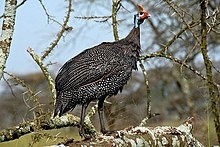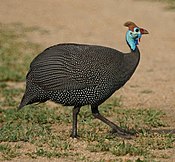Guineafowl
| Guineafowl | |
|---|---|

| |
| Helmeted guineafowl (Numida meleagris) | |
| Scientific classification | |
| Domain: | Eukaryota |
| Kingdom: | Animalia |
| Phylum: | Chordata |
| Class: | Aves |
| Order: | Galliformes |
| Superfamily: | Phasianoidea |
| Family: | Numididae Longchamps, 1842 |
Genera
| |
Guineafowl (

Taxonomy and systematics
This is a list of guineafowl
| Subfamily | Image | Genus | Living species |
|---|---|---|---|
| Agelastinae | 
|
Agelastes Bonaparte, 1850 |
|
 |
Acryllium G.R. Gray, 1840 |
| |
| Numidinae |  |
Numida Linnaeus, 1764 |
|
 |
Guttera Wagler, 1832 |
|
Phylogeny
Cladogram based on a study by De Chen and collaborators published in 2021.[2]
Description
The insect- and seed-eating, ground-nesting birds of this family resemble partridges, but with featherless heads, though both members of the genus Guttera have a distinctive black crest, and the vulturine guineafowl has a downy brown patch on the nape. Most species of guineafowl have a dark grey or blackish plumage[3] with dense white spots, but both members of the genus Agelastes lack the spots. While several species are relatively well known, the plumed guineafowl and the two members of the genus Agelastes remain relatively poorly known. These large birds measure 40–71 cm (15+1⁄2–28 in) in length, and weigh 700–1,600 g (1 lb 9 oz – 3 lb 8 oz). Guinea hens weigh more than guinea cocks, possibly because of the larger reproductive organs in the female compared to the male guinea fowl. Also, the presence of relatively larger egg clusters in the dual-purpose guinea hens may be a factor that contributes to the higher body weight of the guinea hens.[citation needed]
Behaviour and ecology
The species for which information is known are normally
Guineafowl travel behind herd animals and beneath
Wild guineafowl are strong flyers. Their breast muscles are dark (aerobic metabolism), enabling them to sustain themselves in flight for considerable distances if hard-pressed. Grass and bush fires are a constant threat to them and flight is the most effective escape.
Some species of guineafowl, like the vulturine, may go without drinking water for extended periods, instead sourcing their moisture from their food. Young guineafowl (called keets) are very sensitive to weather, in particular cold temperatures.
Guinea hens are not known to be good mothers,[5] but in the wild, the guinea hen's mate (a guinea cock) may help tend the young keets during the day by keeping them warm and finding food. Sometimes, more than one cock helps raise the young. Guineafowl (hens and cocks together) make good parents. During warm weather, the cock is unlikely to sit on the keets during the night (leaving that duty to the hen), but may help the hen keep them warm at night when temperatures drop below freezing.
Guineafowl may be trained to go into a coop (instead of roosting in trees) when very young. Once hatched and ready to leave the brooder (around three weeks), they may be enclosed in a coop for at least three days so they learn where "home" is. When guinea parents (that already roost in a coop) raise their own keets, the hen sits on them outdoors at night, but then the parents teach the keets to also go into the coop in the evenings around three weeks of age.
Males and females have different calls, which can be used to differentiate between them.[6] Unlike chickens (which generally do best with one rooster for a flock of hens[7]), guinea fowl do well with one cock for each hen.
Guineafowl have been shown to act as a deterrent to foxes. [8] Due to the spread of Lyme disease from ticks, Guineafowl are often kept because they will eat the ticks.[9]
Distribution and habitat
Guineafowl species are found across
The helmeted guinea fowl has been introduced in East Africa, South America, the West Indies, the United States, Britain, and India, where it is raised as food or pets.[1]
Guineafowl as food
Guineafowl meat is moist, firmer and leaner than
Gallery
-
Head of a vulturine guineafowl
-
Guineafowl in Benin
References
- ^ ISBN 978-0-7136-7006-6.
- PMID 34809586.
- ^ "Guinea Fowl - Missouri". Cub Creek Science and Animal Camp. Retrieved 2018-10-20.
- ^ (Madge and McGowan, p. 345–352)
- ^ "Are Guinea Hens the Worst Moms of All?". backyardpoultry.iamcountryside.com. 2019-05-08. Retrieved 2019-11-20.
- ^ "Guinea Hen: All You Need To Know (Complete Care Guide)". www.thehappychickencoop.com. 27 August 2021.
- ^ "How many roosters can I have?from My Pet Chicken". My Pet Chicken. Retrieved 2019-11-20.
- ^ "Which Animals Protect Chickens From Foxes?". poultryowner.com. 30 July 2019.
- ^ "Ticking Off the Ticks?". www.communitychickens.com. 8 May 2020.
- ^ USDA handbook #8 and circular #549, leclercq 1985
- ^ "Guinea Fowl Production" (PDF). Archived from the original (PDF) on 2015-07-01. Retrieved 2014-11-06.
Further reading
- Madge and McGowan, Pheasants, Partridges and Grouse. ISBN 0-7136-3966-0
- Martínez, I. (1994). "Family Numididae (Guineafowl)", p. 554–570 in; del Hoyo, J., Elliott, A. & Sargatal, J. eds. Handbook of the Birds of the World, Vol. 2. New World Vultures to Guineafowl. Lynx Edicions, ISBN 84-87334-15-6
External links
 Media related to Numididae at Wikimedia Commons
Media related to Numididae at Wikimedia Commons- Guineafowl videos on the Internet Bird Collection
- SPPA article on Guinea Fowl Early Birds: Guinea Fowl by Dennis Headley






